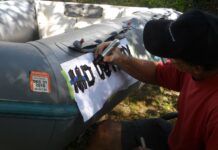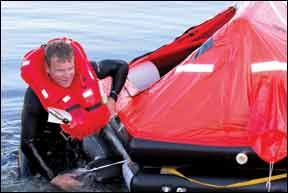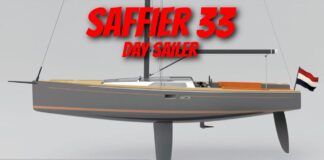Editors Note: Michael Tougias is the author of several books on true survival stories, including Ten Hours Until Dawn, The Finest Hours (soon to be a Disney movie), and his 2013 book, A Storm Too Soon, which well review in the July issue and is now available in PSs online bookstore. Tougias also gives slide presentations about these survival stories throughout the Northeast. To learn more, visit www.michaeltougias.com.
In the course of writing five books about accidents and survival at sea, I interviewed many survivors who shared with me the things they would have done differently, as well as what helped them survive. They did this to help prevent accidents and help those who find themselves in trouble. Here are some of their tips and insights.
Before Your Trip
Double check your gear. With all the gear we stow on a boat, its easy to overlook or forget to pack the one thing that might mean the difference between life and death. While researching my book Overboard!, I learned that Capt. Tom Tighe forgot to pack the boats drogue. Tighe had sailed from Connecticut to Bermuda and back again 24 different times. He encountered rough weather on some of those trips, but never had to use a drogue to slow the boat down when he was riding out a storm. He might have grown complacent; he might have simply forgotten; but for whatever reason, he didnt have this crucial piece of equipment when it was needed most, in a storm that dwarfed all the others.
A safety-gear checklist might have kept him from forgetting the drogue, and a checklist of action to take when a storm approaches might have saved his life. When you are in the middle of a storm, especially when seasick or sleep deprived, its easy to forget some of the steps necessary to prepare the boat for bad weather. First mate Loch Reidy, who was swept off the boat during the storm, told me that when the bad weather first hit, exhaustion was the enemy. We had storm shutters on the vessel, Reidy told me, but in our exhausted state, we forgot to secure them. Then when we finally remembered, it was too late. A wave blew out one of the windows over the settee, and that started a domino effect of problems that eventually resulted in Tighes death.
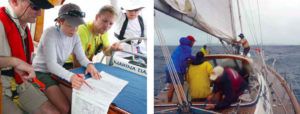
Reidy surprised me by saying that despite his ordeal of being alone in a storm-tossed ocean for 28 hours before rescue, he would make the trip again-with one exception. Thank God I had a strobe light fastened to my life vest. That was the only way a Coast Guard plane spotted me at night. So when I go on a future trip, Ill be sure to have a strobe, but I will also have a personal EPIRB.
When Reidy was swept off the boat, the EPIRB stayed with the boat, and the waves and wind pushed him miles from where the boat drifted. Coast Guard aircraft searched for 24 straight hours before they finally found Lochs location and alerted an oil tanker to steam toward the adrift victim for rescue.
Practice boarding a life raft. Although you may not be able to simulate storm conditions, becoming familiar with the life raft and the challenges inherent to boarding it will help prepare you should a real emergency arise.
Survivors have said that once the life raft inflates, the wind takes it like a kite. Meant to break free if the boat sinks, the raft tether is thin by design, and it is extremely difficult to get a good grip on it. Reidy and Tighe had difficulty pulling the life raft back to the boat just after it inflated and the wind took it. The tether cut right into their hands, and Reidy was forced to dive from the boat to the life raft to get a heavier line on it, so it could be brought to the boat.

Color matters. In May 2007, a pre-season storm in the Atlantic developed into Sub-tropical Storm Andrea. The raging weather capsized the Sean Seymour II, a 44-foot Beneteau, off the Carolinas, and the three crew had to abandon ship as their boat slipped under the sea. Luckily, Capt. Jean Pierre JP deLutz had been able to free the life raft from where it lay impaled by a mast spreader when the boat capsized. In order to release the raft from its entanglement with the spreader, deLutz had to rip off the rafts orange canopy. The remaining part of the raft was black-not too easy to see from the air.
I interviewed the seven Coast Guard C-130 aircrew who searched for the Sean Seymour crew. They flew directly over the life raft twice and never saw it. Finally, what caught their eye was the yellow foul-weather gear that two of the men were wearing. On the radio transcript from the C-130, the commander says, We just located a makeshift life raft, with two men on board! In actuality, there were three men on that life raft. One of them had on red foul-weather gear, and that color is not nearly as distinguishing in the ocean as yellow. The color of the life raft, the color of the foul-weather gear-even these little things can save your life.
When the men first abandoned ship, the life raft became entangled in some lines, and the captain thought they’d be dragged down with the sailboat. Luckily, the man in the red foul-weather gear had just bought a knife a week earlier and had it strapped to his belt. That knife helped save their lives.

Have backups on board. After his rescue, deLutz spent many hours reviewing the disaster, drawing safety lessons from it. First and foremost was that redundancy can make a big difference in the outcome. Pumps are never redundant, said deLutz, referring to the fact that they can clog or fail, or you might only be able to reach one. But he also pointed out that back-ups of other equipment saved his life. Our new GPIRB failed to transmit after 20 minutes. Luckily, I had an 11-year-old EPIRB on board, and that was the signal the Coast Guard picked up.
DeLutz also recommended having all your security equipment grouped together in the most accessible area of the cabin. On his vessel, the survival suits were in a rear port deck locker, which could not be opened because the mast had fallen on it.
On Your Voyage
Most of the storms Ive written about were unexpected, and far beyond anything most sailors will ever see, but even a relatively small storm can jeopardize crew safety. You obviously want to monitor weather forecasts around the clock; however, that is not enough.
Peter Brown (whose father owned the ill-fated Andrea Gail of The Perfect Storm fame) encountered a storm of unbelievable proportions on Georges Bank. The storm happened in 1980, but Brown has not forgotten the major lesson: Be your own weatherman and be conservative.
I scrutinize the weather from a number of sources, Brown once told me. Ive become my own weatherman. I watch patterns, and if I think safety will be an issue, Ill change my plans. I never want to see conditions like that again, never want to see another crew member on my boat lost because of a bad forecast. In almost every one of the accidents Ive investigated, the storm did not behave as predicted. Err on the side of caution.
And if you are off the Eastern seaboard, in the Gulf Stream, and bad weather is approaching, move out of the stream. In my research and interviews, I learned that waves in the Gulf Stream are often twice the size of the waves out of the stream. Wind-driven waves, colliding with current flowing in the opposite direction mean steep waves, and steep often means breaking seas.
When Disaster Strikes
Survivors have told me the urge to leave a foundering boat is so strong its overwhelming. I didn’t want to be entombed in the cabin, said Ben Tye, who was with deLutz during the capsizing. I just wanted to see the sky.
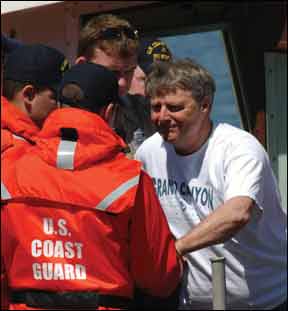
In a storm, it’s normal to assume that with the pounding the boat is taking, it might go down at any minute. Reidy told me that he was 100-percent certain the boat was going to go down quickly. Water was coming in through the broken window and the broken companionway hatch. About a foot (of water) was sloshing around the vessel, and more was coming in. We wanted to have the life raft ready. It was during the preparation of the life raft that Reidy was swept off the vessel. Incredibly, the boat stayed afloat for at least another eight hours. Lesson: Stay with the boat as long as you can. It is your very best life raft, with the most survival supplies. This is easy to say, survivors tell me, but tough to do once the vessel has capsized.
Should you find yourself in the water, or for that matter in any emergency situation, ask yourself, What can I do now to help myself? Just get through the next hour. Reidy told me that one of his mantras while in the water was, Be ready, the Coast Guard will come. And to that end, Reidy fixed a broken strobe that was on Tighes body, and it was that strobe that the Coast Guard saw and that ultimately was his salvation.
For more on marine safety, seamanship, and survival at sea, check out the dozens of Practical Sailor special reports and gear tests that are now online. Gear tests include: life raft test (April and May 2007), EPIRB backups (April 2010) and other survival electronics, storm trysails (August 2008), tethers (August 2010 and September 2011), jacklines (April 2007), inflatable PFD/harnesses (August 2008), rescue lasers (March 2011), and knives (November 2008). Related special reports include: choosing a life raft (March 2007), man-overboard retrieval techniques (January 2010), life raft inspections (February 2013), and safety studies of the Rambler (May 2012) and WingNuts (April 2012) accidents. For a comprehensive look into these and other safety topics, check out PSs Survival at Sea and MOB Prevention and Recovery ebook series, available from our online bookstore.


















